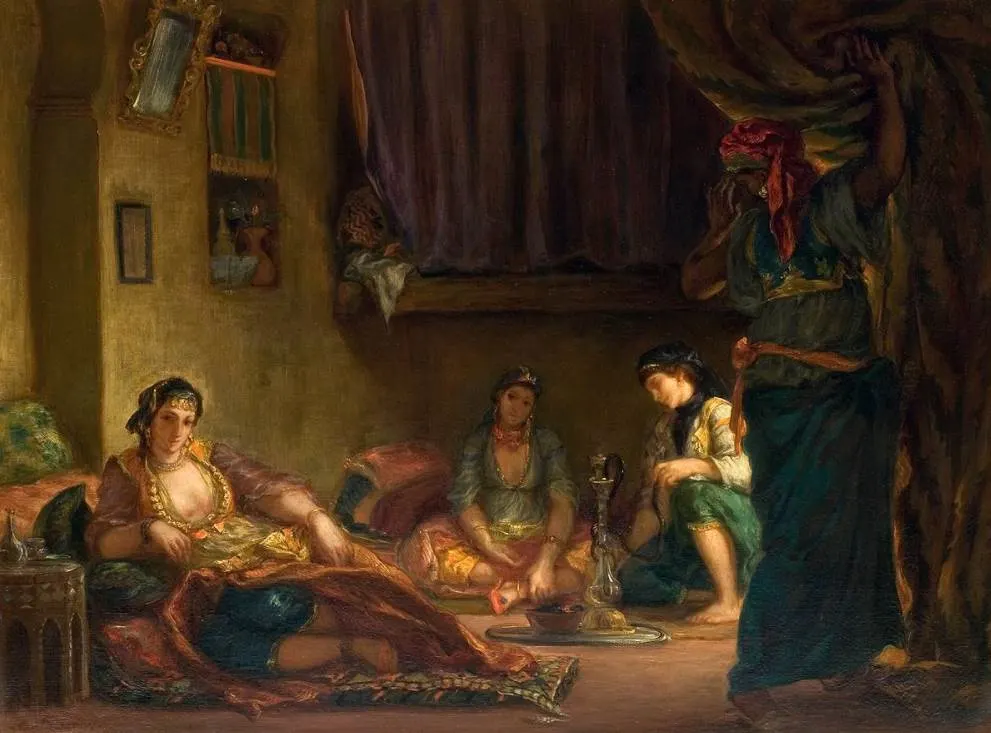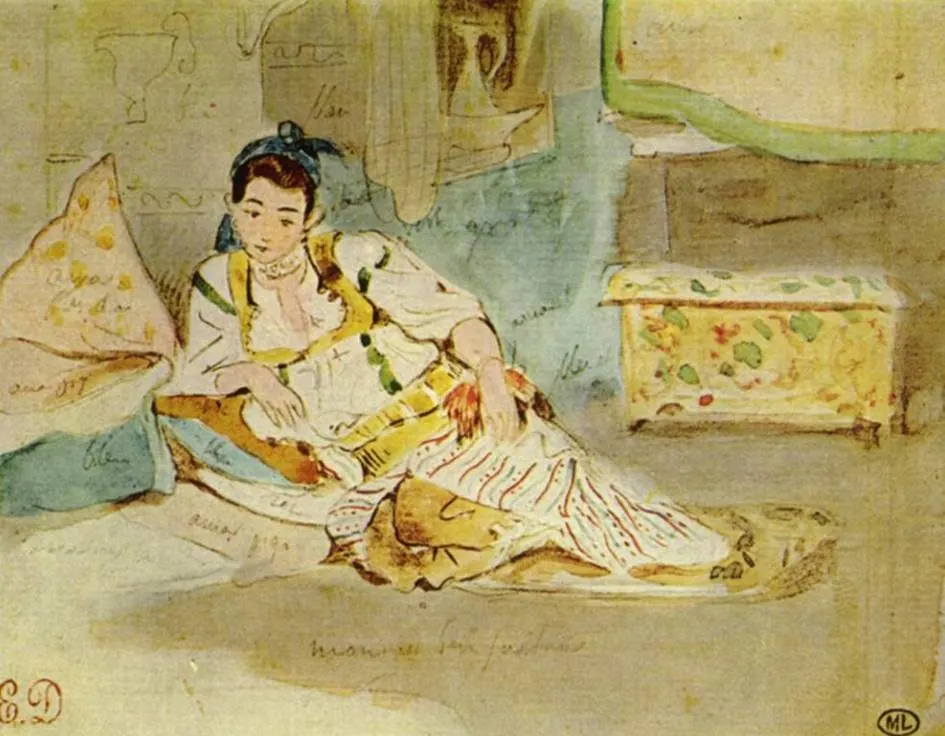When leading Romantic artist of the 19th century Eugène Delacroix (1798-1863) managed to get himself invited to a diplomatic mission in Morocco, he took advantage of it to paint the local people.
Painting Arabic women was a daunting task due to the strict religious customs, but the French artist still managed to do so because of a stroke of luck.
Let’s take a closer look at some of the most interesting facts about Women of Algiers by Eugène Delacroix, two of the most fascinating paintings in the artist’s oeuvre for several reasons.
1. It was painted 2 years after a 6-month trip to North Africa
Eugène Delacroix was born in 1798, remarkably the year that Orientalism became popular in France because of the Egyptian campaign of Napoleon.
He became fascinated by everything exotic, something emphasized by his works related to the Greek War of Independence. These are The Massacre at Chios (1824) and Greece Expiring on the Ruins of Missolonghi (1826), 2 paintings he produced shortly after his breakthrough in the early 1820s.
Delacroix was an influential figure, not surprisingly because his father was the Minister of Foreign Affairs during the aftermath of the French Revolution. This gave him powerful connections which tremendously helped his career.
These connections managed him to accompany a diplomatic mission to Morrocco shortly after the Conquest of Algeria by France began in 1830. The party arrived in Tangiers, Marocco, on January 25, 1832, and they spent over 6 months in North Africa.
During this period, his fascination with everything exotic only grew and he made numerous drawings and sketches. He produced Women of Algiers in 1834, 2 years after he came back to France, and the painting was displayed at the Paris Salon that year.

2. The second version of the painting was produced during the late 1840s
The painting depicts 3 Arabic women as they sit in an enclosed room. A black enslaved woman can be seen leaving the heavily ornamented room. The women wear expensive clothes and jewelry, something that emphasizes the fact that this is the harem of a rich Arabic man.

Delacroix painted a second version of this painting between 1847 and 1849. We can see the same women in the same setting in a similar composition as the first painting.

3. There’s a remarkable difference between the two paintings
Both paintings were produced based on several studies the artist made during his stay in Algiers in 1832. We can, however, see a clear difference related to the atmosphere in the paintings.
This is not surprising because he started working on the second version 15 years after his 6-month stay in North Africa. We can differentiate the sense of nostalgia in the second version as opposed to the tense situation in the first.
The woman on the left almost stares the viewer out of the room, emphasizing that she’s unhappy with the situation. In the second painting, she was depicted with inviting eyes in an almost erotic setting as the black woman lifts away the curtain to expose the other women.
The influential Post-Impressionist artist Paul Cézanne (1839-1906) perfectly described the scene as follows:
All this luminous colour… It seems to me that it enters the eye like a glass of wine running into your gullet and it makes you drunk straight away
4. Painting Arabic women in a private setting wasn’t an easy task
The feeling of the artist himself during his stay in North Africa is reflected in the colorful representation of the Arabic Women in their apartment.
This was probably made even stronger because of the mystery that surrounded their private quarters because it wasn’t an easy task getting into them due to religious constraints.
The Jews in Morocco were a lot more inviting than the Arabs and he was able to easily gain access to private events, resulting in paintings such as “The Jewish Bride (1832) and “The Jewish Wedding in Morocco” (1841).
When he tried to sketch Arabic women from a distance, he quickly found them hiding or running away. It was only by a stroke of luck that he managed to gain access to the private harem of a rich merchant.
He traveled back from Morocco via Algeria and stayed there 3 days before embarking on a boat to Spain. He was invited to the merchant’s harem after talking to him at the port in Algeria and was able to create sketches that resulted in the 2 paintings called “Women of Algiers in their Apartment.”

5. Delacroix included several Western elements into the paintings
The main problem of this painting’s subject was the fact that these women were completely baffled by the visit of a strange man in their private space. This was forbidden and can therefore be described as a unique event in their lives.
This notion made it impossible for these women to behave the way they would when they are alone or accompanied by their husbands, completely distorting the realism of the setting.
That’s why Delacroix had to integrate several elements that he was used to himself as opposed to the typical Algerian customs of the 19th century. The artist described the sentiment of his perception of North Africa as follows:
Never in my life have I observed anything more bizarre than the first sight of Tangier. It is a tale out of the Thousand and One Nights… A prodigious mix of races and costumes…This whole world moves about with an activity that seems feverish.
6. The warped fantasy of Orientalism was derived from a popular book
To understand this painting and how he depicted the women, especially in the second version, we need to understand the Oriental myth in the 19th century.
This warped view of reality was strengthened by the increased popularity of a book called “Arabian Nights,” commonly known as “One Thousand and One Nights.” These Islamic folk tales were written during the Islamic Golden Age between the 8th and 14th centuries and translated into French in 1717.
Napoleon’s campaigns in the east revived the interest in everything Eastern and by the time Delacroix came onto the scene, all of France had their view of what a harem looks like on the inside.
Delacroix’s work was unique in the sense that he visited a harem personally. Although his second version of the work became blurred by a veiled eroticism, this was nothing compared to the fantasy paintings produced by some of his colleagues such as “The Turkish Bath” (1862) by Jean-Auguste-Dominique Ingres (1780-1867).

7. How big is Women of Algiers by Eugène Delacroix?
The second version of the painting is significantly smaller than the first as it only has dimensions of 85 x 112 centimeters (33.4 x 44 inches).
The original version was displayed at the Paris Salon of 1834 and has dimensions of 180 x 229 centimeters (70.1 x 90.1 inches).
8. Where are the paintings located today?
The painting was an instant success because of the popularity of Oriental art in the 19th century and the perceived realism of the work in the eyes of contemporary viewers.
The painting served as the inspiration for both Impressionist artists later in the 19th century, and a collection of 15 paintings by Pablo Picasso that the Spanish artist produced between 1954 and 1955.
The painting was instantly purchased by King Louis Philippe of France and he put it on display at the Musée du Luxembourg, a museum that was housed in the eastern wing of the Luxembourg Palace in Paris at the time.
Today, the original 1834-version of the painting is part of the collection of the Louvre in Paris where it has been on display since 1874.
The second version is part of the collection of the Musée Fabre in Montpellier, France.

